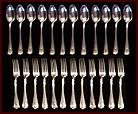Online Encyclopedia of Silver Marks, Hallmarks & Makers' Marks
| |||||||
1. Access to electrical power was very limited at the time. 2. Electrical current was quite weak compared to the present day. After some experimenting, engineers achieved the best results if they used a small bath, put one dozen table spoons and one dozen table forks in it, used 90 Grams of fine silver and then immersed the pieces until the silver anodes were dissolved and the silver had firmly settled on the cutlery. This took many hours and in the beginning made the finished pieces quite expensive. The engineers discovered that a little more than half of the 90 Grams used was spread on the 12 spoons (as they have a bigger surface than the forks), a little less than half was spread on the 12 forks. Using a larger bath would require a much longer plating process, which would have made the process even more expensive. To use more than the 12 + 12 pieces in a bath would result in: 1. The pieces closest to the silver anodes would get a much thicker plating. 2. The pieces farthest from the anodes would get a very thin plating. So the thickness of the silver layer would differ considerably. The plating process was adapted to other pieces of flatware and cutlery; knife-handles, smaller spoons, serving pieces etc., so that the silver layer on them was as thick as on the table spoons and table forks. As the same standard process was used, they all were stamped with the "90". New techniques made it possible to plate more pieces in bigger baths in shorter time, using much larger silver anodes. However, the thickness of the plating remained the same , so the marks remained the same.
1. Pieces that usually come in a dozen (table- forks /-spoons / -knives, coffeespoons etc.) are punched with the weight of silver used for plating a dozen pieces. So tableforks and tablespoons were marked with a "45", smaller pieces were punched a lower figure (e.g. "35"), as less silver was needed to give them the same thickness of plating. 2. Pieces that usually came singly or in pairs (serving pieces) were punched with the weight of silver on a single piece. Examples: If you have a table spoon marked "90" and "45" it means: the standard process as described above was used, on one spoon roughly 1/12 of 45 Grams
This German system of silverplate marking has been adopted by other European countries, and is sometimes seen on Dutch, Danish and Austrian silverplate. France In 1927, Gotthold Kehr wrote an (unpublished) doctoral thesis on the metalware industries of Saxonia, Germany. Having had access to the archives of major German manufacturers, his findings are considered reliable. Kehr notes, without naming his source, that it was Christofle of France, the most important maker of its time, that in the late 1860s, adopted the German production standards (as noted above) to French production - with the other French manufacturers following Christofle's lead.
French silverplate pieces bear two marks: 1. The "84 Gr." (or "12 G." etc.) mark, most often in a square. 2. The maker's mark or retailer's mark, these never came in a lozenge (this form is found only on solid silver), but again most often in a square or rectangle. note; (both marks are sometimes combined, as in the illustrated Christofle example)
|
|---|
Looking to do further research? Have a mark you can't identify? Join the forum.

| © 2000 - 2018 925-1000.com all rights reserved |

